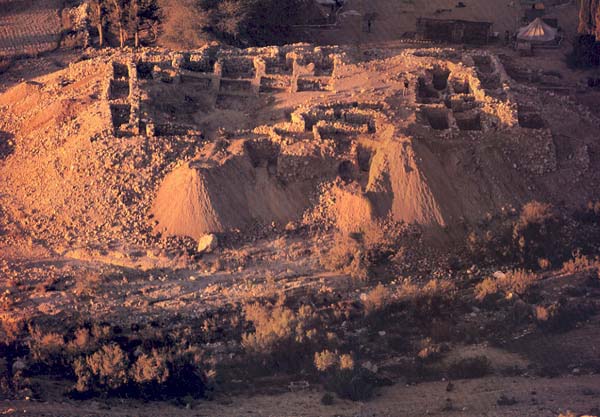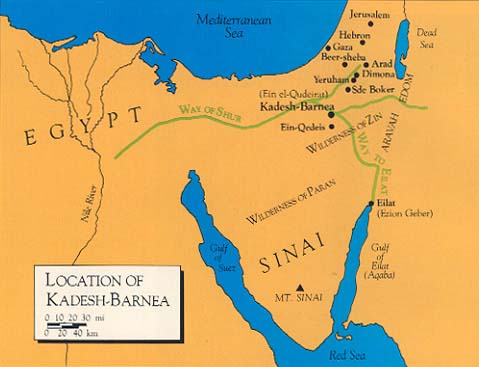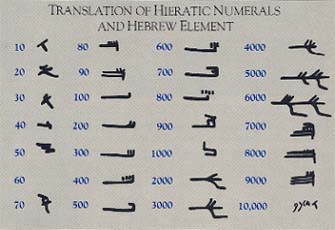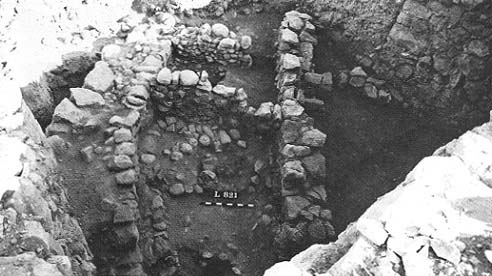Did I Excavate Kadesh-Barnea?
Difficulty of site identification and absence of Exodus remains poses problem
021

The problem of Kadesh-Barnea is simply stated: Has the site been correctly identified? If so, why have we found no remains from the Exodus period?
Kadesh-Barnea was the most important stop on the Exodus. The site also has special connections with Moses and his family. The journey of the Israelites through the desert from Egypt ended at Kadesh-Barnea. Here the Israelite tribes first rallied as one nation having a common spiritual vision. From here, the Israelites attempted to penetrate Canaan. And it was here, at Kadesh-Barnea, that they stayed for a generation.
022
Located between the Wilderness of Paran (Numbers 13:3) and the Wilderness of Zin (Numbers 13:21), Kadesh-Barnea was the site of a series of seminal and dramatic events that befell the wandering Israelites during their years in the desert.

From Kadesh-Barnea, Moses dispatched twelve men (one for each of the twelve tribes) “to spy out the land of Canaan” (Numbers 13:3–21). When the spies returned to Kadesh-Barnea, they gave a discouraging report: “We cannot attack these people; they are stronger than we are … They will swallow us up … The men are of gigantic size” (Numbers 13:31–32). The people despaired of taking the Promised Land, and God, in His anger at their lack of faith, condemned the elder generation to perish in the wilderness. Repentant, yet hoping to circumvent His will, the Israelites hastily went to war against the Amalekites and the Canaanites of the hill country (Numbers 14:40–45), but were utterly defeated and were forced to return to Kadesh-Barnea (Deuteronomy 1:46).
Also at Kadesh-Barnea, Moses’ sister, Miriam, died and was buried (Numbers 20:1).
Here Moses drew water abundantly from the rock when the people complained. But because the people had disputed with the Lord and did not trust him, the site also became known as the Waters of Merivah, or waters of dispute or strife (Numbers 20:2–13).
After Moses’ request for peaceful passage through Edom was refused by the Edomite king, the Israelites set out from Kadesh-Barnea to conquer Canaan by a more circuitous route—around Mount Hor and through Transjordan. Moses’ brother, Aaron, died on Mount Hor because he had been unfaithful to God at the Waters of Merivah by Kadesh (Numbers 33:37, 38).
There are many other Biblical references to Kadesh-Barnea—both earlier and later in Israel’s history. According to Genesis 14:7, Abraham fought the Amalekites at “Ein-Mishpat, which is now Kadesh.” Apparently the original name of the site was Ein-Mishpat, the “Spring of Judgment.” This name seems to reflect a holy or cultic association from a very early period. During the period of the Judges, Kadesh-Barnea marked the southern border of the land allotted to the tribe of Judah (Joshua 15:3).
The actual site of Kadesh-Barnea has long been a subject of scholarly dispute. The earliest 19th century 023investigators, men like Karl von Raumer and Edward Robinson, looked for Kadesh-Barnea in the Aravah, the deep geomorphic rift extending from the southern end of the Dead Sea to the Red Sea. Based on the reference in Numbers 20:16 to Kadesh as being on the border of Edom and the fact that the Aravah was thought to be the western border of Edom, various oases in the Aravah were proposed as the site of Kadesh-Barnea.
In the 1880s, Henry Clay Trumbull suggested Ein-Qedeis, in the northern Sinai, as the site of Kadesh-Barnea. What appeared to be the retention of the Biblical “Kadesh” in the Arabic “Qedeis” was a forceful and appealing argument in favor of Trumbull’s identification. Moreover, Trumbull described Ein-Qedeis as a luxuriant oasis which seemed to fit the Biblical description of the site. Unfortunately, Trumbull’s description of Ein-Qedeis was highly romanticized. In fact, Ein-Qedeis is a shallow pool of water surrounded by a desert wasteland. Ein-Qedeis could not have been a major ancient center like Kadesh-Barnea.
In 1905, Nathaniel Schmidt first identified Kadesh-Barnea as the modern site of Ein el-Qudeirat. Schmidt marshalled his arguments: “The sheltered position, the broad stream of water, the comparatively luxuriant vegetation, the impressive ‘tell,’ the well-constructed pool, the traces of ancient buildings, clearly indicate the importance of this place”—and all these factors seemed to point to the site’s identification as Kadesh-Barnea.

Schmidt’s proposal was subsequently supported by many other scholars, including C. L. Woolley and T. E. Lawrence, who, in 1914, were the first to study the remains on the tell. The identification of Kadesh-Barnea with Ein el-Qudeirat is generally accepted today. Its strategic location on two important ancient routes, its abundance of water and its correspondence with Biblical geography makes this the most likely candidate; no other 024site offers a convincing alternative.
The tell at Kadesh-Barnea (formerly Tell el-Qudeirat and now called Tela Kadesh-Barnea) is scenically located in the deep, narrow valley of the Wadi el-Ein, at the crossroads of two of the most important desert routes in antiquity: (1) the Way of Shur, leading from Edom and the Aravah down to Egypt; and (2) the way from Eilat and the Central Negev to Arad and Hebron.
The springs of Ein el-Qudeirat are the richest and most abundant in the Sinai; they water the largest oasis in northern Sinai. The site today is remarkably lovely, with acre after acre of fruit and nut trees cultivated by the local Bedouin. The tell was resurveyed several times since Woolley and Lawrence studied it—by Nelson Glueck, by Roland de Vaux, and by Yohanan Aharoni. In 1956, the first excavations were carried out by Moshe Dothan, and between 1976–1979, I led five seasons of excavations at Ein el-Qudeirat on behalf of Israel’s Department of Antiquities and Museums.

Our archaeological excavations have revealed the ruins of three Iron Age (Israelite) fortresses on the tell, each, 028except for the first, built over its predecessor. These fortresses date from the tenth to the sixth centuries B.C. and provide important data which help flesh out the tangled history of this period.
The uppermost, and therefore latest, fortress at Kadesh-Barnea is rectangular, about 200 feet long and 135 feet wide. The walls of this fortress consist of casemates, that is, a double wall with irregularly placed cross-walls which form rooms for storage or living. These rooms are between 15 and 30 feet long. Large towers project from each corner of the fortress and smaller towers were built in the middle of each of the four sides. Rough-hewn local limestone blocks were used to construct the fortress. The fortress interior was densely built up. Parallel to the casemate walls on all four sides was a row of rooms, enclosing a central courtyard. Except for a small area paved with stone, the floors were of beaten earth.

On the floor of this fortress we found many complete pottery vessels, both wheel-made and hand-made, including bowls, jugs, juglets, storage jars, pithoib, oil lamps, cooking pots, and flasks, all belonging to the seventh-sixth centuries B.C. Two especially lovely juglets were of Phoenician origin. From this level of the fortress we also found some beads and an iron arrowhead. A fragment of a ceramic figurine was unearthed which appears to be the head and torso of a man with a pinched face. The arms are broken off. Originally, the figurine was probably mounted on a horse, a familiar figurine of the period. From the interior rooms surrounding the courtyard we uncovered an ancient Hebrew ostraconc containing three consecutive letters of the alphabet, and another Hebrew ostracon bearing four or five very blurred lines which are as yet undeciphered.


One of the most important finds was a large ostracon discovered in 11 fragments on the floor of a casemate room located in the southern wall of the upper fortress. Pieced together, the ostracon measured 30 cm. (12 inches) in maximum length, 22 cm. (9 inches) in maximum width, and 5 mm. (.2 inches) in average thickness. It is still incomplete; four fragments are obviously missing. Although the study of the ostracon is only in a preliminary stage, it is possible to state that the ostracon consists of six vertical columns of mainly ancient Egyptian hieraticd numerals and weight symbols. In 030several places Hebrew elements appear—the symbol for shekel and the word alafim which means “thousands.” The shekel sign and alafim are used in combination with hieratic numerals. After considering the list’s repetitive character—numbers written several times, sometimes with the shekel sign and sometimes without—our preliminary view is that the ostracon probably is an exercise in scribal recording.e Some scholars interpret the presence of hieratic numerals as an indication of either Egyptian control or the presence of mercenary troops. My belief is that the hieratic numerals occur simply because of Egypt’s cultural influence in this area. This influence seems to have extended north to Aradf and to Judean sites where ostraca were also found which bear hieratic numerals.



I mentioned one small area of the fortress which was paved with stones. This area, about 30 × 45 feet, adjacent to the northern row of rooms next to the casemate wall, had been surrounded by a wall. On the western edge of this area, we found a round mud-brick installation about 4.5 feet in diameter. It was remarkably preserved to a height of about four feet. This round structure was originally hollow, but had been filled with ashes. It was surrounded by small stone walls. Nearby we found a hand-made ceramic incense burner and many animal bones. This area was probably a cultic center of some sort, but we are still puzzled as to the function of the round installation. Perhaps BAR readers will have some suggestions. This cultic area has some similarities to a stone-paved sanctuary excavated by Yohanan Aharoni at the Judean fortress at Arad, which dates to the ninth century B.C. We hope to learn more about this cultic area of Kadesh-Barnea in future excavations.


Underneath this uppermost fortress were the remains of another, earlier fortress. Its walls were about 13 feet wide; unlike those of the uppermost fortress, they were solid. These walls ran directly under those of the upper fortress. The eight projecting towers of the later fortress were attached to this earlier structure. So the basic ground plan of the earlier fortress must have been the same as its successor. The earlier fortress also contained interior structures. An inner stone wall, with the upper courses composed of mud-brick, ran parallel to the outer wall, and 032presumably formed dwelling rooms for the fortress inhabitants. The pottery, found in a layer of ashes that covered the floors of these rooms, dated to the eighth-seventh centuries B.C.

The remains of a third fortress, the earliest, were found in the southeastern corner of the tell. The depth of the overlying debris prevented us from determining its ground plan until our 1979 season. At that time, we opened a new area on the eastern side of the tell below and between two of the projecting towers of the later fortresses. Here we found the remains of two casemate rooms, a clear indication that, like the uppermost fortress, this fortress also had casemate walls. However, the walls of this earliest fortress were curved and continued on a different line than the later rectangular structures. Apparently, the earliest fortress at Kadesh-Barnea had an oval ground plan, similar to the plan of fortresses dating from the same period uncovered at Ein-Qedeis and Atar Haroa near Sde Boker. We were able to date this earliest fortress at Kadesh-Barnea by discovering on its floor in an ash layer wheel-made and hand-made pottery characteristic of the tenth-ninth centuries B.C. This fortress was established on virgin soil; nothing earlier appears.


In all three fortresses at Kadesh-Barnea we found large quantities of crude, hand-made pottery known as “Negev ware.” It is typical of Iron Age sites in the Central and Southern Negev. Nelson Glueck, an American rabbi and archaeologist, was the first person to excavate and identify this pottery. Because of its coarse material, and the proximity to smelting sites of places where this pottery was found, Glueck conjectured that it had been used as crucibles. It soon became apparent, however, that Negev ware was too common to serve this limited purpose. Moreover, lamps, cups and other vessels made of the same ware could not have been used as crucibles. Aharoni proposed that Negev ware had been produced by seminomadic potters in the Negev, and had served mainly for domestic purposes. Glueck subsequently subscribed to this idea, and attributed the hand-made ware to semi-sedentary inhabitants of the Negev: the Kenites, the Rechabites, the Calebites and the Yerahmeelites. However, as a result of the recent discovery of some accumulations of Negev pottery from which distribution patterns emerge, I believe Negev ware is related specifically to the Kenites, one of the Negev’s nomadic tribes which, according to the Bible, had an especially close relationship with the Israelites from the time of the Exodus onward (see Numbers 10:29; Judges 4:11; 1 Samuel 15:6).

“Negev” pottery cannot be used for dating purposes. On the contrary, it must be dated on the basis of wheel-made pottery found with it. The earliest Negev 033pottery has been dated in this way to about the 13th or 12th century B.C., the period of the Exodus. Our excavations at Kadesh-Barnea indicate that Negev ware continued to be produced until the end of the Iron Age—that is, until the destruction of the First Temple in 587 B.C. The Negev ware found at Kadesh-Barnea included cooking pots, kraters, cups, and bowls of various kinds, some with knobs or ledge-handles, which seem to imitate wheel-made bowls from elsewhere in the country. Among the more unusual items, which have expanded the corpus of known “Negev” types, are three oil lamps, a small chalice and the incense burner, referred to above. These more experimental forms are associated primarily with the later levels of the site.

The earliest fortress at Kadesh-Barnea belonged to an extensive fortress network which ran across the Central Negev, extending south from present-day Dimona, past Yeruham and Sde Boker, to the edge of the erosion crater of Makhtesh Ramon, and then turning west toward the site of Kadesh-Barnea. Scores of such fortresses have been recorded since Woolley and Lawrence’s pioneering survey in 1914. In my opinion, this network of fortresses was established by King Solomon to protect his trade routes and to secure his southern border. Most of these fortresses were occupied only briefly, and were apparently destroyed in the course of Pharaoh Shishak’s invasion of Palestine in about 920 B.C.g following King Solomon’s death (1 Kings 14:25–26). After Pharaoh Shishak’s attack, the Kingdom of Judah withdrew to its old boundary along the Beersheva basin, and the fortress network in the Central Negev was never rebuilt. At Kadesh-Barnea, however, a fortress was re-established in the eighth-seventh centuries B.C. over its predecessor’s remains. This middle fortress with its solid walls and projecting towers, was probably built by Uzziah of Judah (784–733), the king who regained control of Edom, campaigned against the North Arabian tribes, and rebuilt the port of Ezion-Geber on the Gulf of Aqaba.

This second fortress at Kadesh-Barnea was also destroyed, only to be followed in the seventh-sixth centuries B.C. by the third and final fortress. Josiah, King of Judah (c. 640–609 B.C.), who vigorously reasserted his nation’s independence and power, was probably responsible for building the third fortress. This fortress existed until the end of the Iron Age and was evidently destroyed, along with the Kingdom of Judah, in the onslaught by Nebuchadnezzar, king of Babylon.


It is significant that, of all the Iron Age fortresses in the Central Negev and Sinai, only Kadesh-Barnea was twice rebuilt. Perhaps this was so simply because of its strategic location at the juncture of two main desert routes. Or, perhaps, Kadesh-Barnea was twice rebuilt because its association with Moses and the Exodus made it sacred to the later Israelites. Kadesh-Barnea may have served a religious or cultic purpose as well as a military and diplomatic role.
But, where are the remains from the time of Moses (and of Abraham), from the period of the Exodus, and from the era of the Judges which we would expect to find if this site is, indeed, Kadesh-Barnea? Thus far our excavations have yielded nothing earlier than the tenth century B.C.—the time of King Solomon.
How can we explain this? First of all, the identification of the site is not absolutely certain. The strategic location of the fortress is certainly what we could expect if it is Kadesh-Barnea, the border settlement described in Joshua 15:1–3. On the other hand, we have no written evidence, such as ostraca, establishing that this was the border settlement referred to in Joshua.
The tell at Ein el-Qudeirat has not yet revealed all that is hidden beneath its surface. The excavations have reached virgin soil in only a very few restricted places on the tell. Earlier remains may not extend over the full area of the tell occupied by the later fortresses. The premonarchical remains may be there, but we may not have excavated in those areas where they exist. Another possibility is that these earlier habitations occurred but left no remains.
A final possibility, which some scholars urge, is that the Biblical references are not historical, that they are aetiological stories to explain later events and were in fact composed during the period of the Israelite monarchy.
I think that Ein el-Qudeirat probably is Kadesh-Barnea of the Exodus. But, at least for the present, we cannot be sure which theory explains the absence of archaeological remains from the time of Moses and the Exodus. Perhaps future excavations will give us the answer.
The problem of Kadesh-Barnea is simply stated: Has the site been correctly identified? If so, why have we found no remains from the Exodus period? Kadesh-Barnea was the most important stop on the Exodus. The site also has special connections with Moses and his family. The journey of the Israelites through the desert from Egypt ended at Kadesh-Barnea. Here the Israelite tribes first rallied as one nation having a common spiritual vision. From here, the Israelites attempted to penetrate Canaan. And it was here, at Kadesh-Barnea, that they stayed for a generation. 022 Located between the Wilderness of Paran […]
You have already read your free article for this month. Please join the BAS Library or become an All Access member of BAS to gain full access to this article and so much more.
Already a library member? Log in here.
Institution user? Log in with your IP address or Username
Footnotes
A “tel” or “tell” is an artificial mound formed by accumulated remains. “Tel” is the spelling used with Hebrew site names; “tell” is the spelling used with Arabic site names.
Detailed scholarly analyses of this important ostracon will soon be published by A. Lemaire and H. Vermusée, and independently by Y. Naveh and O. Goldwasser.
Arad was an important fortified Israelite city in the Negev where numerous ostraca were found on several levels of the six-times rebuilt citadel.
